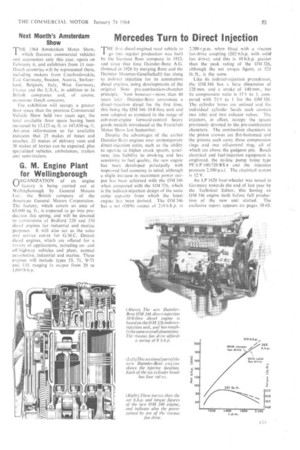Mercedes Turn to Direct Injection
Page 55

If you've noticed an error in this article please click here to report it so we can fix it.
THE first diesel-engined road vehicle to go into regular production was built by the German Benz company in 1923, and since that time Daimler-Benz A.G. (formed in 1926 by merging Benz and the Daimler Motoren-Gesellschaft) has clung to indirect, injection for its automotive diesel engines, using developments of the original Benz pre-combustion-chamber principle. Now however—more than 40 years later -Daimler-Benz announces a direct-injection diesel for the first time, this being the OM 346 10'8-litre unit and now adopted as standard in the range of cab-over-engine forward-control heavy goods models introduced at the Frankfurt Motor Show last September.
Despite the advantages of the earlier Daimler-Benz engines over contemporary direct-injection units, such as the ability to operate at higher crank speeds, quietness, less liability to smoking and less sensitivity to fuel quality, the new engine has been developed principally with improved fuel economy in mind, although a slight increase in -maximum power output has been achieved with the OM 346 when compared with the OM 326, which is the indirect-injection design of the same cubic capacity from which the latest engine has been derived, The OM 346 has a net (DIN) output of 210 b.h.p. at
2200, r.p.m. when fitted with a viscous fan-drive coupling (202 b.h.p. with solid fan drive), and this is 10 b.h.p. greater than the peak rating of the OM 326, although the net torque figure, at 521 lb. ft., is the same
Like its indirect-injection precedessor, the OM 346 has a bore dimension of 128 mm. and a stroke of 140 mm., but its compression ratio is 171 to 1, compared with 21.5 to 1 for the OM 326. The cylinder bores are unlined and the individual cylinder heads each contain two inlet and two exhaust valves. The injectors, in effect, occupy the spaces previously devoted to the pre-combustion chambers. The combustion chambers in the piston crowns are flat-bottomed and the pistons each carry three compression rings and one oil-control ring, all of which are above the gudgeon pin. Bosch electrical and fuel-injection equipment is employed, the in-line pump being type PE 6 P 100/720 RS 4 and the injection pressure 2,500 p.s.i. The electrical system is 11 V.
An LP 1620 four-wheeler was tested in Germany towards the end of last year by the Technical Editor, this having. an OM 346 engine built before full production of the new unit started. The exclusive report appears on pages 58-63.
























































































































